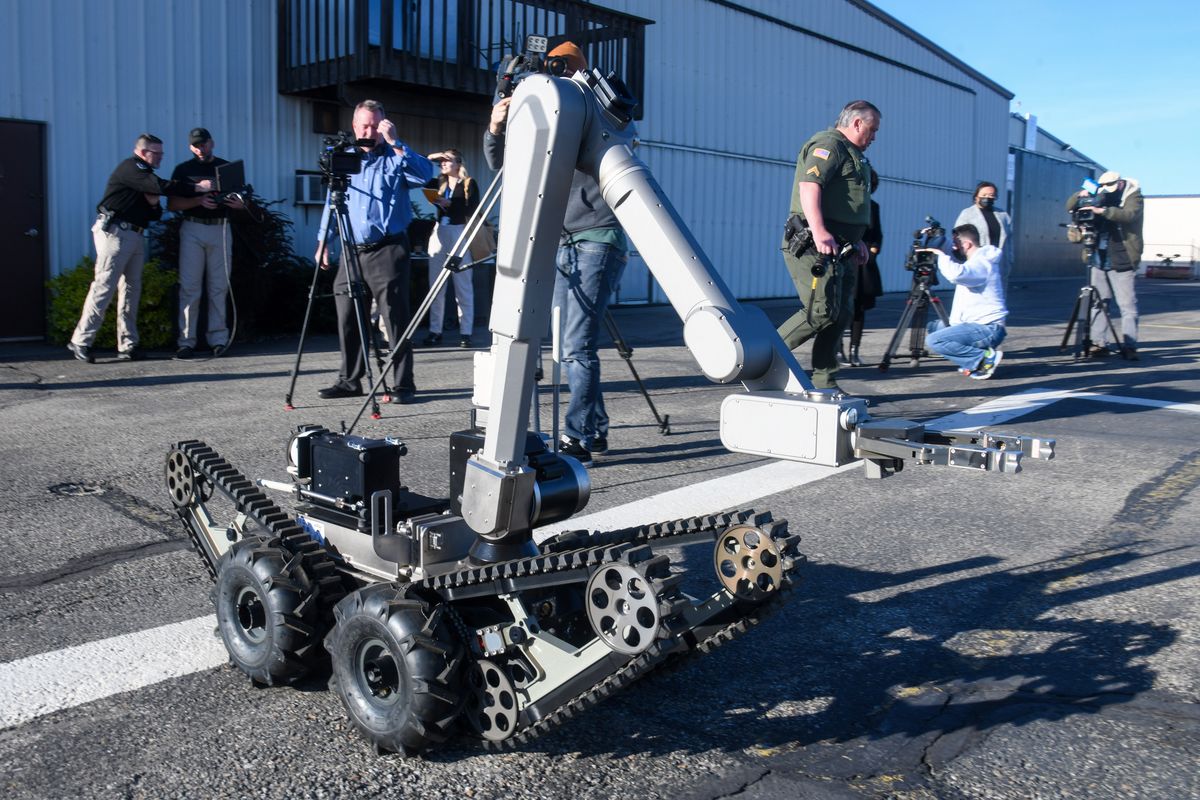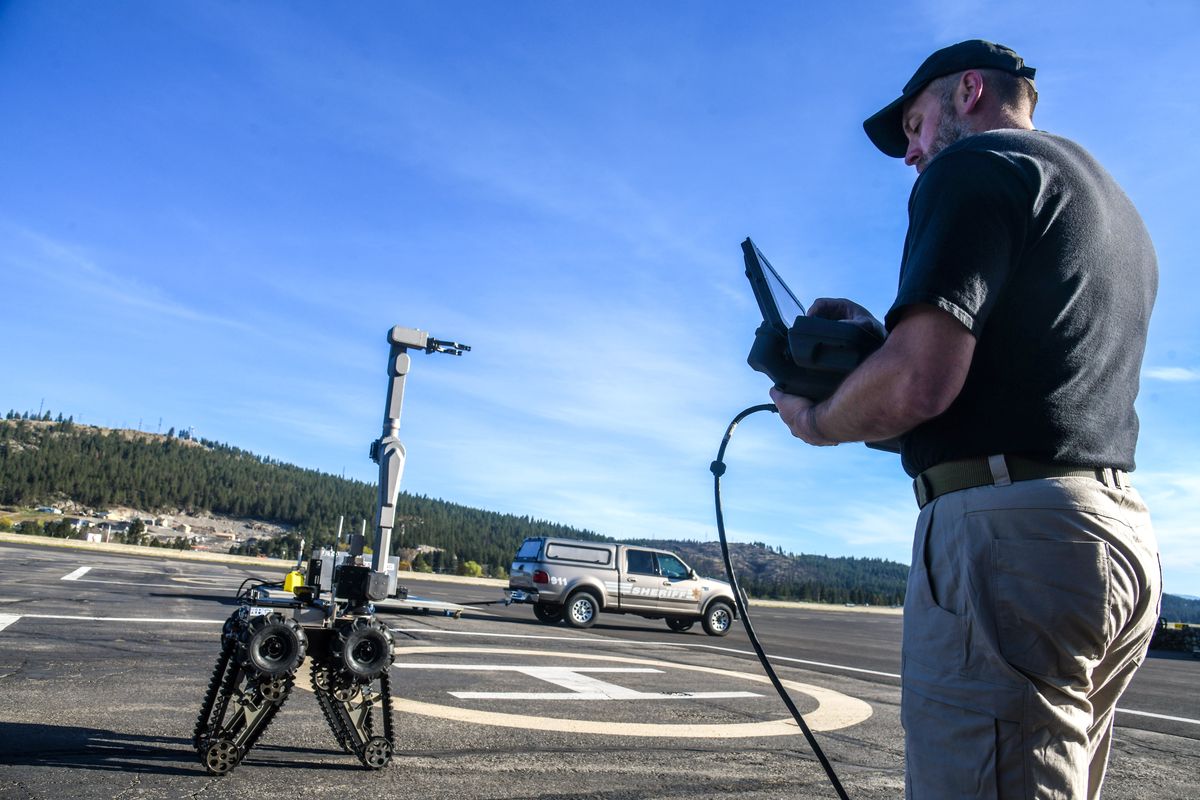New bomb robot makes the Spokane Regional Explosive Disposal Unit’s job safer

When Undersheriff Mike Kittilstved became a member of the Spokane Regional Explosive Unit in 2001, it had one truck, bomb suits and a rudimentary robot.
“You know, our first robot was basically for four wheels,” Kittilstved said. “It had one arm and went up and down, you had to pre-position the wrist where you wanted it, and it had one camera, and really, that was it.”
Two decades later, the unit was able to upgrade to a state-of-the-art robot that provides a better view of explosive devices with three cameras that also can take X-rays and pick things up, all from nearly half a mile away.
“We can actually run the entire call without having to come back to the truck,” he said. “This technology is something that you can’t find on other devices or robots. It significantly lengthens the distance we can be away from it.”
The Spokane Regional Explosive Disposal Unit's new bomb robot, the Telerob, is rolled out for the media, Tuesday, April 27, 2021, at Felts Field. (Dan Pelle/THE SPOKESMAN-REVIEW)Buy a print of this photo
At one of the unit’s training days, bomb technicians demonstrated some of the new robot’s functions Tuesday, as they still figure out everything the new equipment can do.
The Spokane Regional Explosive Unit, often called the bomb squad, recently purchased the $350,000 robot and $75,000 in additional tools with a Department of Homeland Security Grant and one-time funds from the Spokane Police Department and Spokane County Sheriff’s Office, which make up the unit.
The EDU was created in the 1970s and has been certified by the FBI routinely since the 1990s. The unit was just recertified last month, along with receiving a certification from the U.S. Department of Justice.
The unit has 12 bomb technicians and tackles a variety of tasks, from securing explosive devices to doing outreach to STEM programs at local schools, said Lt. Steve Braun, Spokane Police Department bomb squad commander.
One of the most common reasons the bomb squad will be dispatched is for a “render safe,” where someone has found an old explosive device or stick of dynamite, maybe cleaning out their parents’ house , and the unit will go secure it, Braun said.
They handle explosive breaches for area SWAT teams and are called out for suspicious packages, which can be explosive devices, Braun said. The unit also performs protective sweeps for large events like Hoopfest, Braun added.
The bomb squad is the biggest specialty team on the department and responds to an average of 120 calls per year across the entire North Idaho and Eastern Washington region. The unit rarely has openings, with most bomb technicians content to stay on the unit for as long as possible, Braun said.
It takes two years to become a fully certified bomb technician and the spots at the department are competitive, Braun said. The number of slots at each bomb squad for technicians is regulated by the FBI due to limited training availability, Kittilstved said. There are only about 3,000 bomb technicians nationwide, he said.
Purchasing the new robot, formally known as the Telerob Telemax Hybrid, was part of the unit’s long-term plan, Braun said.
“We knew that long-term in our strategic planning for our team, that we needed to replace our older robots, with technologies from the late ‘80s or ‘90s,” Braun said. “We knew long-term we needed to start planning ahead.”
The new robot has three cameras, located at the front, back and roof, and can carry multiple tools. It also has a sentry with another camera that provides another view of the device, and an antenna that extends the robot’s range. The robot’s arm is strong enough to drag a grown man and is easier to maneuver precisely, said Officer Toby Bryer, who is trained to operate the robot.
While Braun and Kittilstved are excited about the new technology, they still plan to use the old robots, especially because the robots get damaged and can go out of service while being repaired.
“I would rather damage that than damage one of my bomb techs,” Braun said.
The unit also recently purchased half a dozen new bomb suits from Med-Eng. The suits weigh 80 pounds and take two people to put them on.
The older suits were clunky and hot, requiring the unit to limit the amount of time technicians wore them, Kittilstved said.
The new suits have gear to make it easier to communicate back and forth, and a microphone for people around the technician to hear them. In the older suits, the technician had to scream for anyone to hear them, Kittilstved said.
The suits also have cooling abilities to allow technicians to wear them for longer and are designed to protect technicians’ backs if they were to get blown away from an explosion.
Each suit costs $35,000 and can be used for approximately seven to 10 years, Kittilstved said.
The unit plans to use the new robot first on most calls before sending in a bomb technician.
They have the mantra, “start remote, stay remote,” Kittilstved said.
Anytime people find a suspicious device or a potential explosive, they should report it to the police department, Braun said. Do not bring potential explosives to the police or fire department, Braun said. Instead, officers will come out to make sure the device is safe, he said.
The unit means what they say. Just hours after Tuesday’s training, they were called to the Spokane County Regional Solid Waste System North Transfer Station after employees noticed a suspicious item.
The device was X-rayed and the pipe was found to be empty and not a threat, but calling the bomb squad was still the right thing to do, the department said. “The biggest message we can send the community is, when in doubt, have us come out and let us do our job so they can stay as safe as possible,” Braun said.







